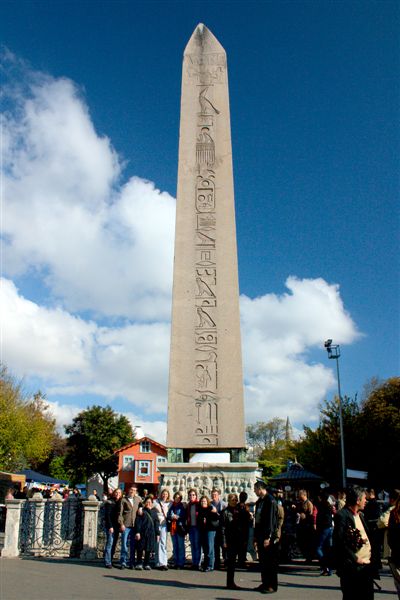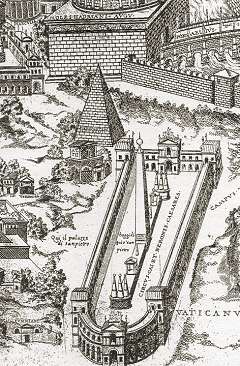|
Caesarea Obelisk
The Caesarea obelisk is a red granite Obelisk 12 metres high (10.5 + 1.4 m), which was erected in the hippodrome of Herod the Great's new-built Roman city of Caesarea Maritima, now Israel. The obelisk seems to have been erected after Herod's time, in the 2nd century CE. The obelisk was discovered in 1980, broken into three sections and buried in the ruins of the hippodrome, where it must originally have been a major feature. It was restored and reerected in 2001. Trophy obelisks were erected in similar urban contexts by Herod's Roman patrons. An obelisk erected in the Hippodrome of Constantinople remains ''in situ''. Another, formerly in the Circus of Nero, Rome, was moved to Saint Peter's Square St. Peter's Square (, ) is a large plaza located directly in front of St. Peter's Basilica in Vatican City, the pope, papal enclave and exclave, enclave in Rome, directly west of the neighborhood (rione) of Borgo (rione of Rome), Borgo. Both t ... in the 16th century. ReferencesCaes ... [...More Info...] [...Related Items...] OR: [Wikipedia] [Google] [Baidu] |
Obelisk
An obelisk (; , diminutive of (') ' spit, nail, pointed pillar') is a tall, slender, tapered monument with four sides and a pyramidal or pyramidion top. Originally constructed by Ancient Egyptians and called ''tekhenu'', the Greeks used the Greek term to describe them, and this word passed into Latin and ultimately English. Though William Thomas used the term correctly in his ''Historie of Italie'' of 1549, by the late sixteenth century (after reduced contact with Italy following the excommunication of Queen Elizabeth), Shakespeare failed to distinguish between pyramids and obelisks in his plays and sonnets. Ancient obelisks are monolithic and consist of a single stone; most modern obelisks are made of several stones. Ancient obelisks Egyptian Obelisks were prominent in the architecture of the ancient Egyptians, and played a vital role in their religion placing them in pairs at the entrance of the temples. The word "obelisk" as used in English today is of Greek rathe ... [...More Info...] [...Related Items...] OR: [Wikipedia] [Google] [Baidu] |
Hippodrome
Hippodrome is a term sometimes used for public entertainment venues of various types. A modern example is the Hippodrome which opened in London in 1900 "combining circus, hippodrome, and stage performances". The term hippodroming refers to fraudulent sporting competitions, such as in racing or baseball. Etymology The word "hippodrome" is derived from Ancient Greek ''hippódromos'' (), a stadium for horse racing and chariot racing. The name itself is a compound of the words ''híppos'' (), meaning "horse", and ''drómos'' (), meaning "course". The ancient Roman counterpart was the circus. Description One end of the ''hippodromos'' of the Ancient Greeks was semicircular, while the other was a quadrilateral with an extensive portico. At the front thereof, at a lower level, were the stalls for the horses and chariots. On either end of the ''hippodromos'' were posts (Greek ''termata'') around which the chariots turned. This was the most dangerous part of the track and the Greeks ... [...More Info...] [...Related Items...] OR: [Wikipedia] [Google] [Baidu] |
Herod The Great
Herod I or Herod the Great () was a History of the Jews in the Roman Empire, Roman Jewish client king of the Herodian kingdom of Judea. He is known for his colossal building projects throughout Judea. Among these works are the rebuilding of the Second Temple#Herod's Temple, Second Temple in Jerusalem and the expansion of its base—the Western Wall being part of it. Vital details of his life are recorded in the works of the 1st century CE Roman–Jewish historian Josephus. Despite Herod's successes, including forging a new aristocracy, he has been criticized by various historians. His reign polarizes opinion among historians, some viewing his legacy as evidence of success, and some viewing it as a reminder of his tyrannical rule. Herod the Great is described in the Christian Bible as the coordinator of the Massacre of the Innocents. However, most of the New Testament references are to his son Herod Antipas (such as the events leading to the executions of John the Baptist a ... [...More Info...] [...Related Items...] OR: [Wikipedia] [Google] [Baidu] |
Caesarea Maritima
Caesarea () also Caesarea Maritima, Caesarea Palaestinae or Caesarea Stratonis, was an ancient and medieval port city on the coast of the eastern Mediterranean, and later a small fishing village. It was the capital of Judaea (Roman province), Roman Judaea, Syria Palaestina and Palaestina Prima, successively, for a period of 650 years and a major intellectual hub of the Mediterranean. Today, the site is part of the Caesarea National Park, on the western edge of the Sharon plain in Israel. The site was first settled in the 4th century BCE as a Phoenicia, Phoenician colony and trading village known as Abdashtart I, Straton's Tower after the ruler of Sidon. It was enlarged in the 1st century BCE under Hasmonean dynasty, Hasmonean rule, becoming a Jewish village; and in 63 BCE, when the Roman Republic annexed the region, it was declared an autonomous city. It was then significantly enlarged in the Roman period by the Judaea (Roman province), Judaean client King Herod the Great, who ... [...More Info...] [...Related Items...] OR: [Wikipedia] [Google] [Baidu] |
Hippodrome Of Constantinople
The Hippodrome of Constantinople (; ; ) was a Roman circus, circus that was the sporting and social centre of Constantinople, capital of the Byzantine Empire. Today it is a square in Istanbul, Turkey, known as Sultanahmet Square (). The word ''hippodrome'' comes from the Greek (), horse, and (), path or way. For this reason, it is sometimes also called ("Horse Square") in Turkish. Horse racing and chariot racing were popular pastimes in the ancient world and hippodromes were common features of Greek cities in the Hellenistic, Ancient Rome, Roman, and Byzantine eras. History and use Construction Although the Hippodrome is usually associated with Constantinople's days of glory as an imperial capital, it actually predates that era. The first Hippodrome was built when the city was called Byzantium, and was a provincial town of moderate importance. In AD 203 the Emperor Septimius Severus rebuilt the city and expanded its city wall, walls, endowing it with a hippodrome, an ... [...More Info...] [...Related Items...] OR: [Wikipedia] [Google] [Baidu] |
Circus Of Nero
The so-called Circus of Nero or Circus of Caligula was a circus (building), circus in ancient Rome, located mostly in the present-day Vatican City. It was first built under Caligula. History The ''Ager Vaticanus'', the alluvial plain outside the city walls on the west bank of the Tiber, was developed at the end of the first century BC, allowing patrician families to construct luxurious private residences (''Horti''). The Horti Agrippinae villa-estate belonged to Agrippina the Elder and was inherited by her son Caligula (r. 31–41 AD). He was a chariot-racing enthusiast and began construction of the circus which was completed by Claudius (r. 41-54 AD). The privately owned ''circus'' and ''Horti'' were then inherited by Nero who made the circus public so he could invite them to cheer him on. He also used both of these to lodge Romans made homeless by the great fire of 64. The circus was used in 65 to carry out mass executions of the Christians accused as scapegoats of the f ... [...More Info...] [...Related Items...] OR: [Wikipedia] [Google] [Baidu] |
Saint Peter's Square
St. Peter's Square (, ) is a large plaza located directly in front of St. Peter's Basilica in Vatican City, the pope, papal enclave and exclave, enclave in Rome, directly west of the neighborhood (rione) of Borgo (rione of Rome), Borgo. Both the square and the basilica are named after Saint Peter, an apostle of Jesus whom Catholics consider the first Pope. At the centre of the square is the Vatican obelisk, an List of Egyptian obelisks#Vaticano, ancient Egyptian obelisk erected at the current site in 1586. Gian Lorenzo Bernini designed the square almost 100 years later, including the massive Tuscan colonnades, four columns deep, which embrace visitors in "the maternal arms of Mother Church". A granite fountain constructed by Bernini in 1675 matches another fountain designed by Carlo Maderno in 1613. History The open space which lies before the basilica was redesigned by Gian Lorenzo Bernini from 1656 to 1667, under the direction of Pope Alexander VII, as an appropriate foreco ... [...More Info...] [...Related Items...] OR: [Wikipedia] [Google] [Baidu] |
Ancient Obelisks
Ancient history is a time period from the beginning of writing and recorded human history through late antiquity. The span of recorded history is roughly 5,000 years, beginning with the development of Sumerian cuneiform script. Ancient history covers all continents inhabited by humans in the period 3000 BCAD 500, ending with the expansion of Islam in late antiquity. The three-age system periodises ancient history into the Stone Age, the Bronze Age, and the Iron Age, with recorded history generally considered to begin with the Bronze Age. The start and end of the three ages vary between world regions. In many regions the Bronze Age is generally considered to begin a few centuries prior to 3000 BC, while the end of the Iron Age varies from the early first millennium BC in some regions to the late first millennium AD in others. During the time period of ancient history, the world population was exponentially increasing due to the Neolithic Revolution, which was in full progr ... [...More Info...] [...Related Items...] OR: [Wikipedia] [Google] [Baidu] |
Former Buildings And Structures In Israel
A former is an object, such as a template, gauge or cutting die, which is used to form something such as a boat's hull. Typically, a former gives shape to a structure that may have complex curvature. A former may become an integral part of the finished structure, as in an aircraft fuselage, or it may be removable, being used in the construction process and then discarded or re-used. Aircraft formers Formers are used in the construction of aircraft fuselage, of which a typical fuselage has a series from the nose cone to the empennage, typically perpendicular to the longitudinal axis of the aircraft. The primary purpose of formers is to establish the shape of the fuselage and reduce the column length of stringers to prevent instability. Formers are typically attached to longerons, which support the skin of the aircraft. The "former-and-longeron" technique (also called stations and stringers) was adopted from boat construction, and was typical of light aircraft built until th ... [...More Info...] [...Related Items...] OR: [Wikipedia] [Google] [Baidu] |





